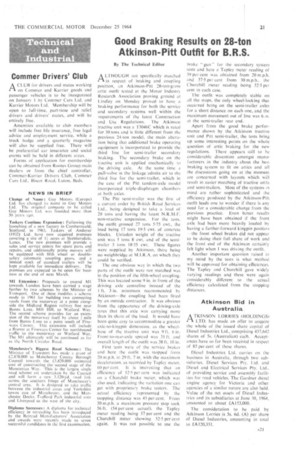Good Braking Results on 28-ton Atkinson-Pitt Outfit for B.R.S.
Page 23

If you've noticed an error in this article please click here to report it so we can fix it.
By The technical Editor
ALTHOUGH not specifically matched in respect of braking and coupling position, an Atkinson-Pitt 28-ton-gross artic outfit tested at the Motor industry Research Association proving ground at Lindley on Monday proved to have a braking performance for both the service and secondary systems well within the requirements of the latest Construction and Use Regulations. The Atkinson tractive unit was a T3046C which is rated for 30 tons and is little different from the previous 24-ton model, the main alteration being that additional brake operating equipment is incorporated to provide thethird line for semi-trailer secondary braking. The secondary brake on the tractive unit is applied mechanically to the driving axle. At the same time a pull-valve in the linkage admits air to the third line for the semi-trailer, which in the case of the Pitt tandem-axle model incorporated triple-diaphragm chambers at both axles.
The Pitt semi-trailer was the lirst of a current order by British Road services Ltd.. being designed to take a load of 20 tons and having the latest N.R.M.F. non-reactive suspension. For the tests, the outfit grossed 27 tons 5.75 cwt.. the load being 17 tons 19.5 cwt. of concrete blocks. Unladen weight of the tractive unit was 5 tons 8 cwt. and of the semitrailer 3 tons 18.35 cwt. These figures were supplied by Atkinson. there being no weighbridge at on which they could be verified.
The one obvious way in which the two parts of the outfit were not matched was in the position of the fifth-wheel coupling. This was located some 9 in. in front of the driving axle centreline instead of the I ft. 3 in. minimum recommended by Atkinson—the coupling had been fined by an outside contractor. It was obvious from the appearance of the driving-axle tyres that this axle was carrying more than its share of the load. It would have been quite easy to accommodate a greater axle-to-kingpin dimension, as the wheelbase of the tractive unit was 9 ft. 6 in. Front-to-rear-axle spread was 31 ft. and overall length of the outfit was 38 ft. 10 in.
First tests were of the service brakes and here the outfit was stopped from 20 m.p.h. in 29 ft. 7 in, with the maximum deceleration, as recorded by Tapley meter, 60 per cent. It is interesting that an efficiency of 52.5 per cent was indicated on a Churchill brake meter, which was also used, indicating the variation one Can get with proprietary brake testers. The actual efficiency represented by the stopping distance Was 45 per cent. From 30 m.p.h. a maximum pressure slop took 56 ft. (54 per cent actual), the Tapley meter reading being 57 per cent and the Churchill meter showing 52-5 per cent again. It was not possible to use the brake "gun " for the secondary system tests and here a Tapley meter reading of 39 per cent was obtained from 20 m.p.h. and 37.5 per cent from 30 m.p.h.. the Churchill meter reading being 32.5 per cent in each case.
The outfit was completely stable on all the stops, the only wheel-locking that ocean-red being on the semi-trailer axles for a short distance on each one, and the maximum movement out of line was 6 in. at the semi-trailer rear end.
Apart from the good brake performance shown by the Atkinson tractive unit and Pitt semi-trailer, the tests bring up some interesting points on the whole question of artic braking for the new regulations. There appears still to be considerable dissention amongst manufacturers in the industry about the best braking system to tit on artics and all the discussions going on at the moment are concerned with layouts which will result in easier matching of tractive units and semi-trailers. Most of the systems in mind are rather sophisticated and the efficiency produced by the Atkinson-Pitt outfit leads one to wonder if there is any need for a considerable change from the previous practice. Even better results might have been obtained if the front axle had been more heavily loaded by having a farther-fOrward kingpin position —the front wheel brakes did not appear to be doing their full share of work and the front end of the Atkinson certainly felt light when I was driving the outfit.
Another important question raised in my mind by the tests is what method will be approved for obtaining efficiences. The Tapley and Churchill gave widely varying readings and these were again considerably different to the actual efficiency calculated from the stopping distances.
Atkinson Bid in Australia
TK INSON LORRIES HOLDINGS) I-1 LTD. has made an offer to acquire the whole of the issued share capital of Diesel Industries Ltd., comprising 437,642 shares of 5s. (Australian) each. Acceptances have so far been received in respect of 85 per cent of these shares.
Diesel Industries Ltd. carries on the business in Australia, through two subsidiaries, Diesel Services Pty. 1.td. and Diesel and Electrical Services Pty. Ltd.. of providing service and assembly facilities for road vehicles. The Gardner diesel engine agency for Victoria and other agencies of a similar nature are also held. Value of the net assets of Diesel Industries and its subsidiaries at June 30, 1964, amounted to about fA153,000.
The consideration to be paid by Atkinson Lorries is 5s. 6d. (A) per share of Diesel Industries, amounting in total to LA 120,351.








































































